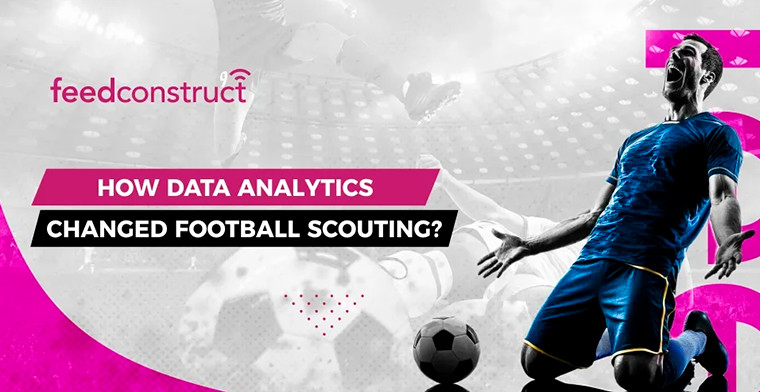Feedconstruct: How data analytics changed football scouting?
Friday 28 de July 2023 / 12:00
2 minutos de lectura
(London).- Data analytics has brought a big change to football scouting, combining strategy and passion in the game. Football clubs now have valuable data from player stats, performance metrics, and key variables, which helps them make data-driven decisions. It provides an advanced way to find players and talent, replacing outdated instincts. This article explores how data analytics influences football scouting, helping clubs gain a competitive edge in today's football landscape.

Data Analytics in Football Scouting: Types and Sources of Data
First, let's take a look at the data used by football scouts and where they get it. Football scouts utilise player performance, tactical, injury, and even social media data. These valuable pieces of information come from various sources, such as match footage, tracking technologies, wearables, interactions with fans and specialised football scout data databases that focus on player statistics and potential talent analysis.
Player Performance Data: This data is crucial for evaluating players' on-field abilities. It includes statistics like goals scored, assists, successful tackles, passing accuracy, shots on target, and more. This information helps compare players across different positions and provides insights into their strengths and weaknesses.
Tactical Data: Tactical data focuses on a team's playing style, formation, and set-piece strategies. It includes information about player positioning, pressing intensity, play patterns, and off-the-ball movement. This data makes understanding a team's preferred tactics and weaknesses easier.
- Injury Data: Football clubs use data analytics to monitor and assess a player's past fitness performance, which is crucial due to the concern about injuries. By tracking injury trends and identifying risk factors, preventive action can be taken to keep players healthy and reduce time away from the field.
- Social Media Data: The growth of social media has provided football clubs with a unique data source. By analysing a player's social media activity, clubs can gain insights into their personality, behaviour, and popularity with fans. This data also helps evaluate a player's marketability and potential influence on the team's reputation.
How is Data Analytics Used in Football?
In football scouting, data analytics plays a crucial role in sifting through vast amounts of data to uncover patterns, trends, and potential talent. Sophisticated algorithms use historical data as benchmarks to analyse player performance metrics, aiding in making informed decisions about player development, team tactics, and player recruitment.
One key application of data analytics is player performance analysis. By objectively measuring a player's contributions across different aspects of the game, clubs can identify players who align well with their tactical philosophy and team needs.
Data analytics also facilitates predictive scouting, helping clubs identify players who match their tactical preferences and team requirements based on their performance in various game aspects.
Moreover, data analytics enables teams to conduct opposition analysis, studying opponents' playing styles and weaknesses. This information allows clubs to tailor their strategies and exploit weaknesses in the opposition's defence, giving them a competitive advantage during matches.
What are the typical sources of data for analytics?
Football clubs utilise a wide range of data sources for their analytics, including:
- Match Footage: Nearly every professional football match is recorded and stored in the current era. Clubs utilise this footage to analyse individual player performances and study team tactics.
- GPS Tracking and Player Monitoring Systems: Players wear GPS tracking devices during training and matches, providing real-time data on player movements, distances covered, and sprinting speeds. This data is valuable in understanding a player's physical workload and recovery needs.
- Wearable Technology: In addition to GPS tracking, wearable technology like heart rate monitors and accelerometers offers further insights into player fitness and exertion levels.
- Online Databases and Archives: Football clubs have access to extensive databases containing historical player performance data, match statistics, and team records. This information helps in benchmarking and player comparisons.
- Social Media Platforms: Data from players' social media activities can provide insights into their off-field behaviours and popularity, influencing marketing and brand strategies.
How Has Data Analysis Transformed Scouting in Football?
Data analysis has completely transformed football scouting by providing teams with unparalleled insights and strategic benefits. Instead of relying on subjective observations, modern scouting uses advanced statistical tools to analyse player performance, tactics, and opposition patterns. Data-driven metrics enable teams to identify player strengths and weaknesses, discover hidden talents, and make well-informed decisions during transfer windows.
Additionally, in-depth opponent analysis allows coaches to create customised game plans and exploit weaknesses, resulting in improved team performance. Integrating data analysis into football scouting has raised the competition level and promoted a more objective and accurate approach to talent identification and player development.
Furthermore, data analytics has completely transformed player valuation in the transfer market. Clubs can now make better-informed decisions about a player's market value by considering various performance metrics and potential contributions to the team.
Data analytics also assists in monitoring a player's progress and development over time. Clubs can pinpoint areas where players need improvement and create customised training programs to enhance their skills.
How Has Data Analytics Changed Football?
The impact of data analytics on football extends beyond scouting, transforming various aspects of the sport. Clubs now utilise data analytics to analyse opponents' tactics, optimise training, improve injury prevention strategies, and make precise decisions on substitutions during games. This data-driven approach has turned football into a strategic game where analytical insights back every move.
Coaches and managers rely on real-time data to make in-game decisions during matches. Analysing player positioning, movement, and performance data helps them make informed substitutions and adjust team formations as needed.
In terms of training and recovery, data analytics plays a crucial role in optimising workout routines, ensuring efficiency, and preventing overexertion. By monitoring players' physical metrics, clubs can manage their workload and reduce the risk of injuries.
How do football clubs use data analytics?
Data analytics plays a significant role in fan engagement and marketing strategies. Clubs use fan data to create personalised experiences, develop targeted marketing campaigns, and boost merchandise sales, enhancing the overall fan experience.
Data analytics offers a significant advantage in analysing opponents' tactics and weaknesses. Studying rival teams' playing styles and identifying patterns allows clubs to develop effective strategies to exploit their vulnerabilities.
Moreover, data analytics provides real-time insights during matches, empowering clubs to make strategic in-game decisions. Whether it's determining the right moment for substitutions or tactical changes based on the game's flow, this data-driven approach can provide teams with a competitive edge.
How Big Data Analytics Is Used for Changing and Improving Football Scouting
Big data analytics is a game-changer for football scouting in today's rapidly changing world of football. Clubs can transform their scouting processes using data insights, leading to better player evaluations, improved tactics, and a competitive edge on the field.
The Future of Football Scouting with Big Data Analytics
In the future, big data analytics, machine learning, and AI will significantly impact football scout data. These advancements will change how players are projected, injury risks are assessed, and tactics are optimised, providing clubs with a substantial competitive edge.
Predictive scouting models enabled by machine learning algorithms will allow clubs to predict player development trajectories more accurately.
Identifying players with high potential and understanding their long-term impact on the team will see significant improvements.
Player tracking technology advancements will offer coaches and trainers deeper insights into players' movements and behaviour on the field. This improved accuracy and granularity of performance data will greatly benefit clubs when assessing player performance.
Choose the Right Data Partner for Football Scouting
Selecting the right sports data provider as a partner is vital for those aiming to benefit from data analytics. An ideal data partner must provide reliable access to detailed and precise data, advanced analytics tools, and a successful history in football scouting.
Key Considerations When Choosing a Data Partner for Football Scouting
When choosing a partner for football scouting and analytics, it is essential to consider specific criteria. Some of them include:
- Accurate and Up-to-Date Data: The partner must offer reliable information for effective scout data analysis.
- Advanced Analytics: They should have strong analytics capabilities to extract valuable insights from the data.
- Football Scouting Experience: Choose partners with a successful football scouting and analytics track record.
Challenges and Limitations of Data Analytics in Football Scouting
Integrating data analytics in football scouting poses challenges and limitations. Despite its potential, data accuracy and quality are crucial. Incomplete or inaccurate data can lead to flawed player assessments and strategic choices. Moreover, clubs merge data from diverse sources, like various leagues and competitions, to gain a complete view of player performance.
Data Privacy and Security Concerns in Football Scouting
Data analytics presents vast opportunities but also raises important data privacy and security concerns in football scouting. Safeguarding player performance data, health information, and fan data requires strong measures against breaches and unauthorised access. Data leaked or misused could harm player privacy and team strategies, leading to negative outcomes. Compliance with data protection regulations becomes essential as football clubs manage sensitive information.
The Human Factor: Integrating Data Insights with Subjective Evaluations
In football scout data, combining data insights with subjective evaluations remains vital. While data analytics offers valuable quantitative information, it cannot completely replace the human element in player assessments. Scouting involves understanding intangible qualities like player temperament, leadership abilities, and adaptability to different playing styles. Coaches and scouts bring their experience and intuition, complementing the objective data-driven approach. Striking a balance between data insights and subjective evaluations enables clubs to make well-rounded and informed decisions when identifying talent and building cohesive team dynamics.
Overreliance on Data: Potential Pitfalls and Biases
The use of data analytics has transformed football scouting, but it comes with a risk of overreliance. Depending solely on data-driven metrics may overlook important qualities that are hard to quantify. Intangible attributes like determination, work ethic, and performance under pressure greatly influence players. Also, biases can arise from historical preferences or past scouting patterns within the data. To address these concerns, clubs should be aware of the limitations of data analytics and balance it with subjective assessments.
The Future of Football Scouting
The future of football scouting is evolving alongside the sport itself. Data analytics will play an increasingly vital role in transforming scouting methods. Advancements in machine learning and artificial intelligence will offer deeper insights from vast player data, leading to more accurate player projections and talent identification. Real-time data integration during matches will become smoother, providing coaches with instant information for on-field strategic decisions. Moreover, player tracking technology will advance, offering detailed information on player movements and performance, enriching the scout data analysis. As data analytics continues to shape football scouting, clubs that embrace these innovations will gain a competitive advantage in talent acquisition and team performance.
Conclusion
Data analytics has revolutionised football scouting, blending objective analysis with subjective observations. This data-driven approach has transformed player recruitment, tactical decisions, and game strategies. Football will evolve as clubs continue to leverage data analytics, delivering thrilling moments on and off the field. With access to big data and advanced scout data analysis, clubs can unlock new levels of talent identification and team performance, propelling football to unparalleled heights of excellence.
Categoría:Analysis
Tags: Feedconstruct,
País: United Kingdom
Región: EMEA
Event
G2E - Las Vegas 2025
06 de October 2025
CT Interactive on Innovation, Networking, and Market Growth at G2E 2025
(Las Vegas, SoloAzar Exclusive).- The global gaming industry marked G2E’s 25th anniversary with a major gathering in Las Vegas. CT Interactive stood out for its innovative product development and international growth strategy. Account Manager LATAM at CT Interactive, Roberto Muñoz, shared insights on G2E’s importance, emerging trends, and the company’s collaborative expansion efforts.
Thursday 30 Oct 2025 / 12:00
Atlaslive Explored the Future of Gaming in Latin America at Recent G2E 2025
(Las Vegas, SoloAzar Exclusive).- Bruno Almeida, Head of Sales LATAM at Atlaslive, attended G2E for the first time to explore how land-based and online gaming are converging. His experience highlighted key trends shaping the Latin American market, from immersive casino innovations to strategic networking and regulatory insights.
Monday 27 Oct 2025 / 12:00
G2E 2025: Cristian Galarza, ASAP Director Explains the Importance of Attending the Event
(Las Vegas, SoloAzar Exclusive). - After attending the 25th anniversary edition of G2E in Las Vegas, ASAP’s director shares his perspective on the evolution of the industry, driven by digitalization, efficiency, and the creation of international networks that foster new business opportunities.
Tuesday 28 Oct 2025 / 12:00
SUSCRIBIRSE
Para suscribirse a nuestro newsletter, complete sus datos
Reciba todo el contenido más reciente en su correo electrónico varias veces al mes.



























